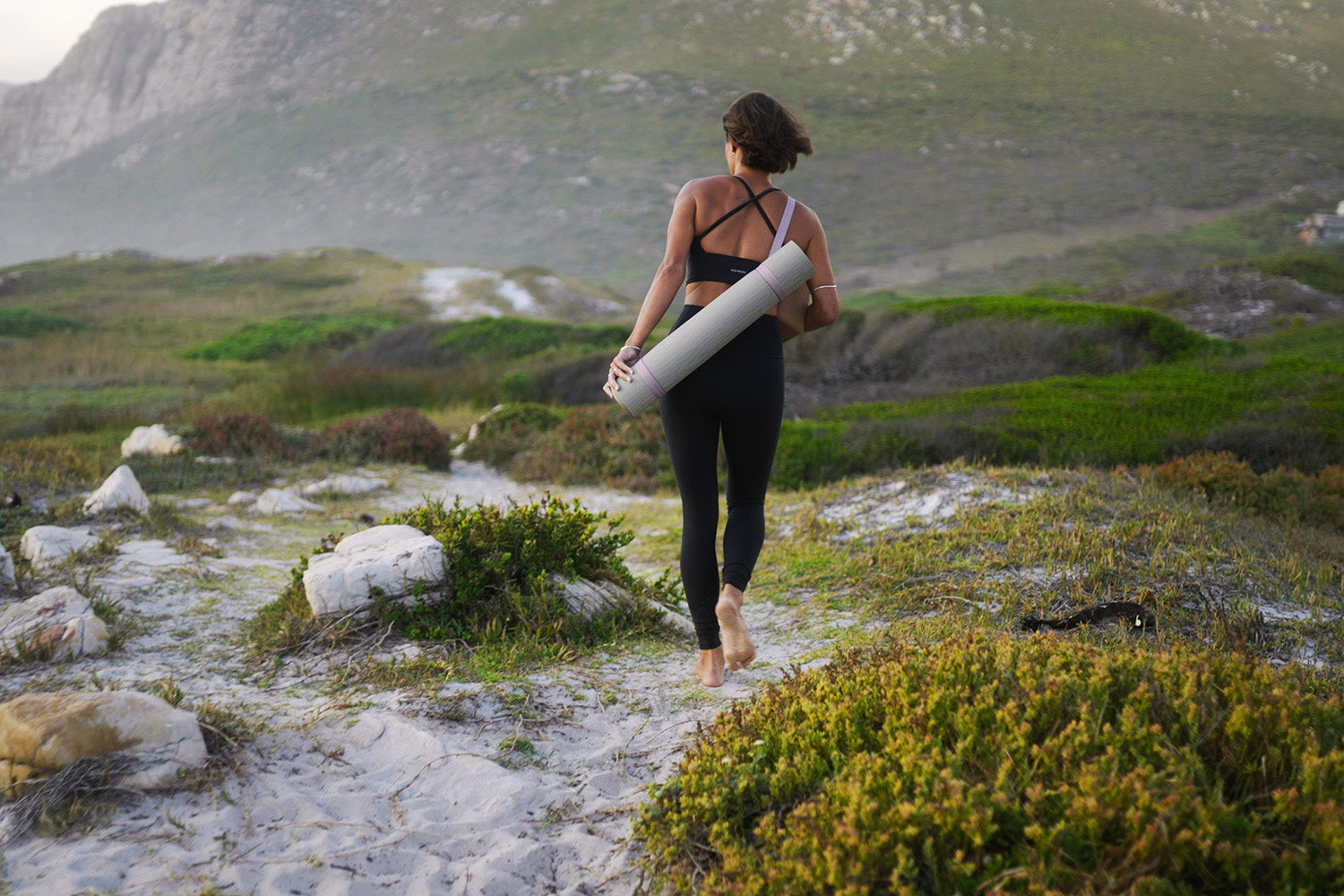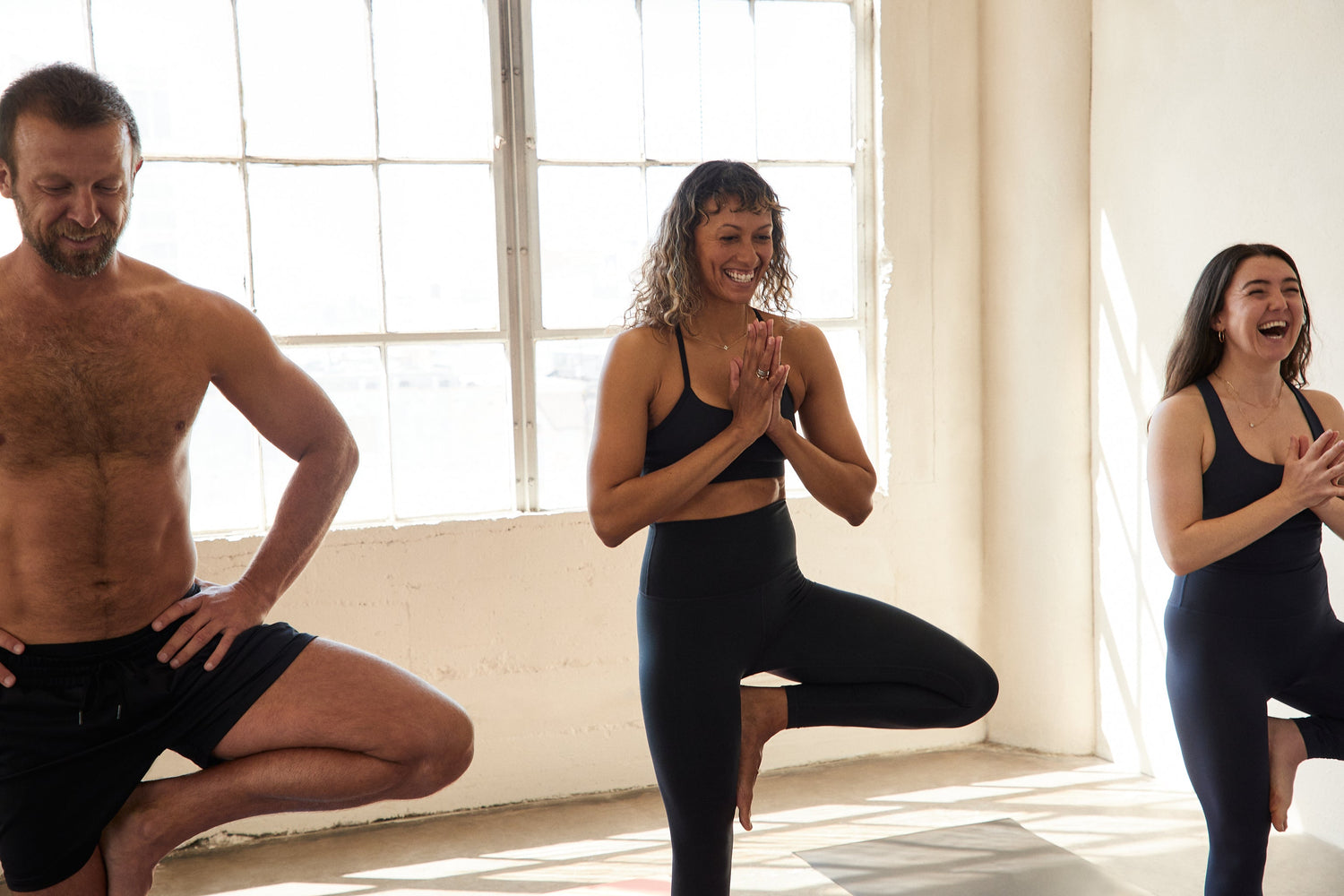It can be scary to walk into a yoga class for the first time, especially if the environment is new to you. The space, time, and even your body may cause you to feel a bit off or unsure when you step on the mat. The beauty of this practice is that its many forms give us so many ways to accept those feelings and learn from them, appreciating them by the end of the class.
When considering how yoga can build our belief in our abilities, we have to think of three parts of the practice: asana, pranayama, and our mindset. Asana is the physical yoga practice that will prepare us to better feel our breathing. Pranayama is the regulation of our breath that results in the movement of energy. Mindset is what you believe about yourself and your practice. When we apply these skills to work, home, and, of course, the yoga studio, we learn to create peace, balance, and confidence.

ASANA: Sun Salutations
Sun salutations prepare the body to respond to the requirements of the day. Take a moment in the mornings to do 1-5 sun salutations as you begin your yoga journey. The movements between mountain poses offer the spine an opportunity to get a backbend and forward fold in before taking on the dreaded demands of an office chair. I like to do these in the morning because activating the nervous system to provide energy or release gives me an understanding of where my abilities are that day. Do I feel tense? Am I carrying anxiety in my shoulders? Not only will these tensions alter my ability to think clearly, but they can lead to poor showings in everyday life. We might snap at someone at work or avoid a conversation due to holding an emotion or idea in our physical body. A consistent yoga practice helps us revert from feeling trapped in our emotions to literally exercising them into a steady and controlled state.
Sun salutations can help: 1) identify areas that may be overused or underused, 2) activate those areas to then become relaxed, and 3) give you a chance to get familiar with your physical body enough to recognize your patterns, your emotions, and your life circumstances. Over time, your practice will grow to one that is responding to the day that passed but also preparing for the day ahead. You'll know when to slow down the pace and take it easy and when to pick it up to build some heat. You'll gain a confidence in how the spirit wants to move and a confidence in what the body can achieve if you take things one step at a time. There's nothing like feeling your shoulders creeping up the back of your neck in anticipation of a painful outcome and being conscious enough to remember your practice, take a deep breath, release the physical tension, and move forward with the thrill of a measured, present response.

PRANAYAMA: Box Breathing
The confidence that it takes to practice the mental, emotional, and physical undertaking of a good yoga class can take your breath away. Our breathing may be challenged by a new yoga posture, much like our confidence can be challenged when taking a step towards a life goal that seems unreachable. Pranayama, or the movement of energy through breathing techniques, is the doorway to reclaiming consciousness and confidence in those moments. Similarly to how we practice our sun salutations by greeting and dispersing anxiety as it presents itself in the physical body, pranayama allows us to examine the fluctuations of the mind.
The pace, depth, and intention of our breath changes when we are under the mental duress caused by thoughts, emotions, longstanding beliefs, and unhealthy habits. From an audible gasp to a choked stream of air through a crack in the lips, our breath is controlled by what we think about.
To stay mindful and respond to the present moment, I use a technique called Box Breathing. Box Breathing, used by Navy Seals to combat high-stress situations, is a technique that can be employed at any time to provide calm. Begin by taking in a deep breath to a count of 4. Hold that breath for a count of 4. Exhale for a count of 4. Hold the air out for a count of 4. Continue 5 times. It's that simple.
Box Breathing engages our parasympathetic nervous system, which controls the body's ability to relax. Our parasympathetic nervous system helps us lower our heart rates, digest our food, and ultimately, relax enough to find our confidence again. Pranayama and our yoga practice are designed to still the fluctuations of the mind. This calm, exuberant focus helps us keep a beginner's mind, remain open to the possibility of any outcome, and become confident in our ability to respond to the outcome in kind.
So, these breaths don't change the circumstances that I'm facing but rather change my perception of and relationship to them. When I'm able to soak in the moment with a full breath, I'm able to better understand my own role and respond calmly and confidently to whatever comes my way.
MINDSET: A Growth Mindset
The yoga practice is unique because by design, it changes your mindset while it changes your body. If you follow a path of yoga that is progressive in design, like Ashtanga Yoga, you will see the body grow stronger, more flexible, and more balanced over time. Fixed ideas about how your body and mind can move start to change faster than the body itself after just a few sessions. This is true of Yin, Dharma, Iyengar and the many other variations of yoga. The mindset that we pick up, no matter the practice, is a growth mindset. There is nowhere in my life where this has been more obvious than in my newest, maddening hobby of late: golf.

Carol Dweck, author of the book Mindset: The New Psychology of Success, defines a fixed mindset as “believing that your qualities are carved in stone.” So often we hear “I can't touch my toes” or “I'm just not that flexible” rattle around in our heads when considering trying something new or difficult. This belief that our identities are defined or “fixed” deteriorates our ability do our best when the assumption is challenged. By believing in these fixed fables, we create a box for ourselves that ultimately doesn't fit our potential or our reality. How then do we change our mindset and how does our yoga practice help us do so?
In contrast, Dweck defines a growth mindset as “the belief that your basic qualities are things that you can cultivate through your efforts.” By considering ourselves separate from the outcome, we golfers (or what have you) are able to hone in on getting better at the process, instead of fixating on becoming the next Tiger Woods. In reality, the terrible golfer hasn't put enough time into growing their game or if they do, they haven't yet found the right instruction. And that's okay. Every “great golfer” has to acknowledge that some days aren't the best. The ability make mistakes while constantly seeking to learn and grow is what makes us great. It's the mindset that determines how we apply ourselves to our own realities, and that is full of opportunity for growth.
When it comes to our yoga practice, we are constantly given opportunities to reset our thinking on the mat. The thought pattern that you learn as your crow pose (bakasana) grows is the same one you can apply to your everyday life. Instead of making statements in your head about being one thing or another ask yourself more questions about your efforts. ”I can't do Crow Pose” becomes “How can I work on my squat to get closer to crow?”
“I'm not that flexible" becomes “What can I do to become more flexible?”
You can also detail your effort for a clearer picture:
“I am a terrible golfer” becomes “I'm putting more time into my putting practice this week.”
Grow your confidence by taking some of the pressure off of your achievements. This non-attachment will continue to work in your favor as you learn to take life one yoga class, deep breath, and mindset shift at at a time.

LEARN ABOUT BRANDON
Brandon Copeland is a passionate and dedicated yoga instructor known for his holistic approach to health and wellness. Brandon's yoga journey began during his college years when he discovered the transformative power of yoga in managing stress and improving overall health. This experience ignited a deep passion within him, leading him to pursue formal training in various yoga disciplines, including Hatha, Vinyasa, and Ashtanga yoga. Brandon is committed to creating a supportive and inclusive environment for his students, emphasizing the importance of mindfulness, breath awareness, and proper alignment in every practice. With over a decade of experience in the practice of yoga, Brandon now focuses his passion on his company and social enterprise, Khepera Wellness. Follow along with Brandon here.








